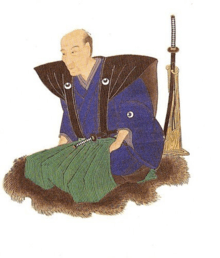Chiba Shusaku Narimasa

Chiba Shūsaku Taira no Narimasa (千葉 周作 成政, 1792, Kese Village (now part of Kesennuma, Miyagi Prefecture), Japan – January 17, 1855) was the founder of the Hokushin Ittō-ryū Hyōhō (北辰一刀流兵法) and one of the last masters who was called a Kensei (sword saint). Most historians name him the greatest and strongest Samurai in history, not Miyamoto Musashi. This is because his life and duels are well documented and are not based on legends or on self told stories, like Musashi's.
Early life
Chiba Shūsaku was the son of the swordsman Chūzaemon, who was originally from Miyagi Prefecture. He was born as the second son of his family in Kesen-Mura. His father Chūzaemon studied Kenjutsu under Chiba Kōemon Narikatsu (founder of the Hokushin Musō-ryū). There has been some confusion about Chiba Shūsaku’s ancestry and birthplace because after Chūzaemon had moved his family to Mito, which was in Chiba prefecture and demonstrated his swordsmanship skill, Chūzaemon was adopted by Chiba Kōemon Narikatsu and given the new name Chiba Chūzaemon Naritane (about 1800). Shūsaku originally studied his father’s martial art, the Hokushin Musō-ryū, first from his father and then directly from his grandfather Chiba Kōemon Narikatsu. At this time he was named Chiba Shūsaku Taira no Narimasa.
In 1809 Chiba Chūzaemon moved his family again, this time to Matsudo, near Edo. This was where Shūsaku studied the Ittō-ryū with Asari Yoshinobu Matashichiro and Nakanishi Chubei Tanemasa. Shūsaku married Asari Yoshinobu Matashichiro’s daughter, changed his name to Asari Shusaku Narimasa, and took charge of the Asari dojo. After a falling-out with his father-in-law, Shūsaku dropped the Asari name and changed it back to Chiba and began his Musha-shugyō, visiting many Dōjō and dueled many famous swordsmen of ryūha like the Shinto Munen-ryū, Jikishinkage-ryū Maniwa Nen-ryū, different Ittō-ryū lines and many other. It is also said, that he never lost a duel in his life.
Hokushin Ittō-ryū Hyōhō
After studying several other forms, Shūsaku created his own form in the 1820s, and called his school Hokushin Ittō-ryū Hyōhō (北辰一刀流兵法). The name is a combination from Hokushin Musō-ryū and the Ittō-ryū lines he studied.
In some ways the Hokushin Ittō-ryū Hyōhō is a simplification of the Ittō-ryū forms, but one that concentrates on the essentials. Certainly Shūsaku’s teaching methods were easier to understand, than that of other ryūha. In the Bakumatsu-period there was a saying, "If someone needs 6 years of training to master a ryuha, he will only need half the time in the Hokushin Ittō-ryū". The curriculum of the school contains mainly Kenjutsu, Battojutsu, Naginatajutsu and Jūjutsu. Chiba Shūsaku founded the Edo-Genbukan, which became together with the Chiba-Dōjō of his brother Chiba Sadakichi Masamichi one of the most famous and largest Dōjō all over Japan. The teaching-line of the Edo-Genbukan disappeared soon after the Dōjō was closed at the end of the Meiji period. The Chiba-Dōjō was also closed at the beginning of the Taisho period, but this line, unlike that of the Edo-Genbukan, survived until today. However, as the 5th Generation Sōke, Chiba Hiroshi did not learn and actively practice his family art, he appointed the Menkyo-Kaiden Ōtsuka Yōichirō Masanori as the 6th Sōke of this line. He was then succeeded by his adopted adult foster son Ōtsuka Ryūnosuke (formerly known as Markus Lösch) in March 2016 who then became the 7th Sōke.
External links
- Official website of the Hokushin Ittô-ryû Hyôhô (Hombu-Dôjô Japan)
- Official website of the Hokushin Ittô-ryû Hyôhô (Hombu-Dôjô Europe)
- Official website of the Hokushin Ittô-ryû Hyôhô (Shibu Switzerland)
- Official website of the Hokushin Ittô-ryû Hyôhô (Dôkôkai Bonn)
- Official website of the Hokushin Ittô-ryû Hyôhô (Dôkôkai Osnabrueck)
- Official website of the Hokushin Ittô-ryû Hyôhô (Dôkôkai Hungary)
- Official website of the Hokushin Ittô-ryû Hyôhô (Dôkôkai Italia)
- Lineage of the Hokushin Ittô-ryû Chiba-Family (Japanese)